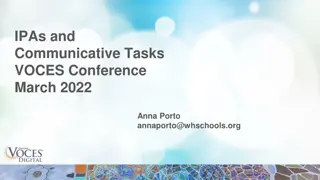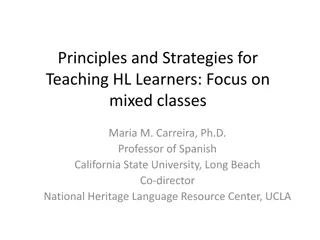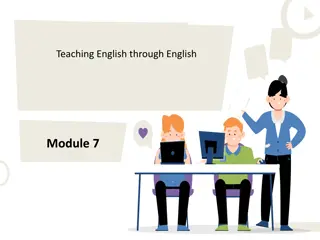Exploring Communicative Language Teaching Fundamentals
Communicative Language Teaching focuses on real-life situations to facilitate meaningful communication. This approach aims to teach language through practical interactions, with a particular lesson goal being to learn how to greet, introduce oneself, and ask about others' names and origins. It emphasizes the purpose and meaningfulness of communication in language learning, highlighting the development of interlanguage unique to each learner's experiences.
Download Presentation

Please find below an Image/Link to download the presentation.
The content on the website is provided AS IS for your information and personal use only. It may not be sold, licensed, or shared on other websites without obtaining consent from the author. Download presentation by click this link. If you encounter any issues during the download, it is possible that the publisher has removed the file from their server.
E N D
Presentation Transcript
The Fundamentals of Communicative Language Teaching Janice M. Aski Department of French and Italian aski.1@osu.edu
Communicative language teaching makes use of real- life situations/contexts that lead to communicating in meaningful ways about particular topics.
What is the PURPOSE of communication in this lesson? What makes it MEANINGFUL?
Communicative Goal of this brief lesson: Students will learn how to greet a classmate, introduce him/herself, ask the name of his/her classmate and where s/he is from.
Which of the following is a communicative goal? A. The objective of this lesson is to teach students expressions for greetings, the first- and second- person forms of the verb to be (e.g. I am from ) and basic question forms. B. In this lesson, students will greet each other and learn where their classmates are from so that we can identify how many people are from Ohio.
Which of the following is a communicative goal? A. In this lesson, students will learn the singular and plural forms of the verb to like and six different Italian foods. B. By the end of the lesson, students will be able to tell their partner which foods they like and do not like from a typical Italian restaurant menu.
Which of the following is a communicative goal? A. The objective of this lesson is find out peoples favorite color and what that color says about their personality. B. The objective of this lesson is to teach students the vocabulary for colors.
Interlanguage is the mental representation of the language being developed by a learner as s/he tries to approximate the target language. Interlanguage is based on the learner s personal experiences with the language, so no two learners have the same interlanguage at any particular point in time.
Interlanguage is created through: A. Positive evidence: the correct language model provided by the instructor and the text and B. Negative evidence: when there is a mismatch between the learner s language and the target.
Just because you have taught it doesn t mean that they have acquired it!
Students need multiple exposures to a structure in different contexts in order to acquire it.
Students will keep getting it wrong until all the evidence has been processed and the structure has been incorporated into their interlanguage system.
Bottom line: Errors are good and acquisition takes time!
Change the model sentence, substituting the correct form of the verb. Model: I go to the store. Instructor s cueStudent response 1. you You go to the store. 2. he He goes to the store. 3. she She goes to the store. 4. we We go to the store.
Il ristorante da Luigi Le patatine fritte Il vino La bistecca I dolci La pizza Gli spaghetti
Effective language tasks: 1. jigsaw tasks 2. information gap tasks
Jigsaw task: Mamma! What if you were trying to find long-lost family members and you had some pieces of information, but not many, to go on? Your instructor will give each student a card with information about an imaginary person on it (name, marital status, city in which s/he lives, profession, ect.). Everyone will go around the room, meet each other and ask and answer questions in Italian to find the other members of their imaginary families. When you think you ve found everyone, sit down together in a group. When everyone is seated, be prepared to introduce your family member(s) to the rest of the class. (Aski and Musumeci 2006:116)
Information gap activity: Discovering Sandra and Alberto s weekly schedules Part 1: With the class, create appropriate descriptions of Sandra and Alberto. Remember to include their ages, physical and emotional characteristics and likes/dislikes. Sandra Alberto
Part 2: Work in pairs. Your instructor will give you two agendas. One partner completes the weekly agenda for Sandra and the other completes the agenda for Alberto. Sample agenda for Sandra (Alberto s is the same): Sandra Thursday Friday Saturday Sunday 1 PM 7 PM 10 PM
Part 3: Complete the second agenda by asking your partner questions about the agenda s/he completed in the second part of the activity. Example: S1: What does Alberto do at 10 PM on Saturday? S2: He studies and then goes to bed. (Adapted from Aski and Musumeci 2006)
Our Goal: MEANINGFUL PURPOSEFUL INTERACTION
Works cited and helpful resources Aski, Janice M. and Diane Musumeci. 2006. Avanti! 2nd edition. Boston: McGraw Hill. Brandl, Klaus. 2008. NeCommunicative Language Teaching in Action: Putting Princlples to Work. w Jersey: Prentice Hall. Gass, Susan M. 1997. Input, Interaction, and the Second Language Learner. Mahwah, New Jersey: Lawrence Erlbaum. Lee, James F. and Bill VanPatten. 2003. Making Communicative Language Teaching Happen. Boston: McGraw Hill. Omaggio Hadley, Alice. 2001. Teaching Language in Context. 3rd edition. Boston: Thompson Heinle. Shrum, Judith L. and Eileen W. Glisan. 2000. Teacher s Handbook. 2nd Edition. Boston: Heinle and Heinle Thompson Learning.























